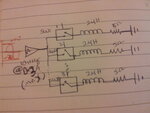zoulzubazz
Member level 5

Hey guys,
I need to switch a 10MHz signal through an array of 8 air-core coils. the maximum peak to peak amplitude of the signal is +-20V and the current i am looking to switch is a maximum of 400mA. The figure attached shows what i am looking to do. I was looking at solid state relays but am not sure if they cant handle signals of 10MHz through them. The switching on/off time required is a few ms. What switch would you recommend for this application? Thanks.

I need to switch a 10MHz signal through an array of 8 air-core coils. the maximum peak to peak amplitude of the signal is +-20V and the current i am looking to switch is a maximum of 400mA. The figure attached shows what i am looking to do. I was looking at solid state relays but am not sure if they cant handle signals of 10MHz through them. The switching on/off time required is a few ms. What switch would you recommend for this application? Thanks.



